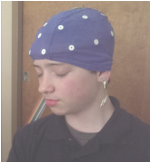Quantitative EEG assessment

QEEG, or quantitative electroencephalogram, is a method for assessing electrical activity in the brain. Sensors that can detect very small amplitudes of electrical activity are placed at 19 sites on the scalp. EEG is then recorded while the client sits quietly. A trained professional then visually inspects the recorded signals, and selects sections of data that are not contaminated by events such as muscle activity, eye blinks, or eye and head movements. These "clean" signals are then analyzed by a computer to quantify various frequencies of brain activity. These results are then compared to EEGs of healthy individuals of similar age, and "brain maps" are derived. Brain maps allow a color-coded visualization of regions that may have too much (red) or too little (blue) of certain types of brain activity.
How is a QEEG brain map used?The QEEG brain map is used to better understand an individual's brain functioning. In addition to determining if there is too much or too little of certain types of brain activity, QEEG can also identify problems with wiring between different brain regions. This information is then used, in combination with 1) knowledge of brain anatomy, 2) a person's symptoms and/or goals, and 3) knowledge of activity patterns associated with clinical disorders to develop protocols for neurofeedback training. Over the course of neurofeedback treatment, the brain is re-assessed with QEEG on a regular basis to monitor progress and adjust treatment protocols.
|
What to expect
Prior to QEEG assessment, a provider will conduct a clinical interview. The actual QEEG assessment, including preparation and recording, usually takes less than two hours. You will be given specific instructions on how to prepare for your QEEG, such as come well-rested and avoid hair products that could interfere with establishing good sensor connections. At the conclusion of the assessment, an appointment will be scheduled to review findings, allowing time for artifact removal, computer analysis, interpretation, and integration with other information.
How to find a provider
QEEG guided neurofeedback is a growing and very exciting field. As can be expected, lots of professionals are eager to enter this field. However, it is important to ensure that you choose a provider who has met the highest standards of training.
At the very least, a neurofeedback provider should be a licensed health services provider by the appropriate state professional board in the state you are receiving treatment, and they should be licensed to treat your specific condition. Board certification in neurofeedback (BCN) also ensures a provider has proper knowledge, training, and experience. Finally, an ideal neurofeedback provider is someone who has specialized training in brain-behavior relationships, such as a neuropsychologist or psychologist. For those providers who use QEEG to guide treatment, additional training in QEEG assessment is essential.
If you have questions regarding a provider's qualifications, please contact the Biofeedback Certification International Alliance or view their website at www.BCIA.org. Another helpful resource is the International Society for Neurofeedback and Research at www.ISNR.net.
At the very least, a neurofeedback provider should be a licensed health services provider by the appropriate state professional board in the state you are receiving treatment, and they should be licensed to treat your specific condition. Board certification in neurofeedback (BCN) also ensures a provider has proper knowledge, training, and experience. Finally, an ideal neurofeedback provider is someone who has specialized training in brain-behavior relationships, such as a neuropsychologist or psychologist. For those providers who use QEEG to guide treatment, additional training in QEEG assessment is essential.
If you have questions regarding a provider's qualifications, please contact the Biofeedback Certification International Alliance or view their website at www.BCIA.org. Another helpful resource is the International Society for Neurofeedback and Research at www.ISNR.net.

